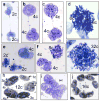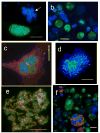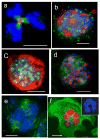Endopolyploidy in irradiated p53-deficient tumour cell lines: persistence of cell division activity in giant cells expressing Aurora-B kinase
- PMID: 18602486
- PMCID: PMC2570184
- DOI: 10.1016/j.cellbi.2008.06.003
Endopolyploidy in irradiated p53-deficient tumour cell lines: persistence of cell division activity in giant cells expressing Aurora-B kinase
Abstract
Recent findings including computerised live imaging suggest that polyploidy cells transiently emerging after severe genotoxic stress (and named 'endopolyploid cells') may have a role in tumour regrowth after anti-cancer treatment. Until now, mostly the factors enabling metaphase were studied in them. Here we investigate the mitotic activities and the role of Aurora-B, in view of potential depolyploidisation of these cells, because Aurora-B kinase is responsible for coordination and completion of mitosis. We observed that endopolyploid giant cells are formed via different means in irradiated p53 tumours, by: (1) division/fusion of daughter cells creating early multi-nucleated cells; (2) asynchronous division/fusion of sub-nuclei of these multi-nucleated cells; (3) a series of polyploidising mitoses reverting replicative interphase from aborted metaphase and forming giant cells with a single nucleus; (4) micronucleation of arrested metaphases enclosing genome fragments; or (5) incomplete division in the multi-polar mitoses forming late multi-nucleated giant cells. We also observed that these activities can release para-diploid cells, although infrequently. While apoptosis typically occurs after a substantial delay in these cells, we also found that approximately 2% of the endopolyploid cells evade apoptosis and senescence arrest and continue some form of mitotic activity. We describe here that catalytically active Aurora-B kinase is expressed in the nuclei of many endopolyploid cells in interphase, as well as being present at the centromeres, mitotic spindle and cleavage furrow during their attempted mitotes. The totally micronucleated giant cells (containing sub-genomic fragments in multiple micronuclei) represented only the minor fraction which failed to undergo mitosis, and Aurora-B was absent from it. These observations suggest that most endopolyploid tumour cells are not reproductively inert and that Aurora-B may contribute to the establishment of resistant tumours post-irradiation.
Figures








Comment in
-
Ploidy and division in cancer and mosquito hind-gut cells.Cell Biol Int. 2009 Feb;33(2):253. doi: 10.1016/j.cellbi.2008.11.004. Epub 2008 Nov 24. Cell Biol Int. 2009. PMID: 19059490 No abstract available.
References
-
- Adams RR, Eckley DM, Vagnarelli P, Wheatley SP, Gerloff DL, Mackay AM, Svingen PA, Kaufmann SH, Earnshaw WC. Human INCENP colocalizes with the Aurora-B/AIRK2 kinase on chromosomes and is overexpressed in tumour cells. Chromosoma. 2001;110:65–74. - PubMed
-
- Andreassen PR, Lacroix FB, Lohez OD, Margolis RL. Neither p21WAF1 nor 14–3–3 sigma prevents G2 progression to mitotic catastrophe in human colon carcinoma cells after DNA damage, but p21WAF1 induces stable G1 arrest in resulting tetraploid cells. Cancer Res. 2001;61:7660–68. - PubMed
-
- Baroja A, de la Hoz C, Alvarez A, Ispizua A, Bilbao J, de Gandarias JM. Genesis and evolution of high-ploidy tumour cells evaluated by means of the proliferation markers p34(cdc2), cyclin B1, PCNA and 3[H]-thymidine. Cell Prolif. 1996;29:89–100. - PubMed
-
- Baroja A, de la Hoz C, Alvarez A, Vielba R, Sarrat R, Aréchaga J, de Gandarias JM. Polyploidization and exit from cell cycle as mechanisms of cultured melanoma cell resistance to methotrexate. Life Sci. 1998;62:2275–82. - PubMed
-
- Carmena M, Earnshaw WC. The cellular geography of aurora kinases. Nature Rev Mol Cell Biol. 2003;4:842–54. - PubMed
Publication types
MeSH terms
Substances
Grants and funding
LinkOut - more resources
Full Text Sources
Research Materials
Miscellaneous

